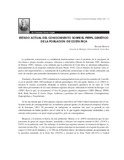Mostrar el registro sencillo del ítem
Estado actual del conocimiento sobre el perfil genético de la población de Costa Rica
| dc.creator | Morera Brenes, Bernal | |
| dc.date.accessioned | 2016-05-26T21:01:42Z | |
| dc.date.available | 2016-05-26T21:01:42Z | |
| dc.date.issued | 2003-10 | |
| dc.identifier.uri | https://hdl.handle.net/10669/27834 | |
| dc.description.abstract | The population of Costa Rica has been considered historically as the product of the amalgamation of three ethnic groups: Europeans, Africans and Amerindians. In addition, it has been said that this population is highly inbred, mainly in the central regions of the country. In order to analyze these aspects of historical origin and the constitution of Costa Rica population, we have been conducting a series of studies that aim to unravel the genetic structure of that population. The results show that the Costa Rican population is certainly trihybrid, similar to those of other countries in Latin America, but differing from them in the proportions of gene flow from the ancestral populations. We found that while some specific regions inside the Central Valley maintain a high average inbreeding coefficient, the general trend towards a temporary decline over time. The percentage of inbreeding (alpha) remains high, but in general is not correlated positively with the alpha value. That suggest the existence of moderate emigrations and more unions between couples with the same geographical origin, but not consanguineous unions. | es_ES |
| dc.language.iso | es | es_ES |
| dc.source | Memoria V Congreso Nacional de Biologia Dr. Clodomiro Picado Twight. 3-5 | es_ES |
| dc.subject | Human genetics | es_ES |
| dc.subject | Admixture | es_ES |
| dc.subject | Inbreeding | es_ES |
| dc.subject | Consanguinity | es_ES |
| dc.subject | Costa Rica | es_ES |
| dc.title | Estado actual del conocimiento sobre el perfil genético de la población de Costa Rica | es_ES |
| dc.type | contribución de congreso | |
| dc.description.procedence | UCR::Vicerrectoría de Docencia::Ciencias Básicas::Facultad de Ciencias::Escuela de Biología | es_ES |
Ficheros en el ítem
Este ítem aparece en la(s) siguiente(s) colección(ones)
-
Biología [1644]


